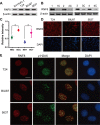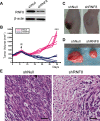Adenovirus-mediated downregulation of the ubiquitin ligase RNF8 sensitizes bladder cancer to radiotherapy
- PMID: 26788910
- PMCID: PMC4891017
- DOI: 10.18632/oncotarget.6909
Adenovirus-mediated downregulation of the ubiquitin ligase RNF8 sensitizes bladder cancer to radiotherapy
Abstract
The ubiquitin ligase RNF8 promotes the DNA damage response (DDR). We observed that the expression of RNF8 was increased in bladder cancer cells and that this change in RNF8 expression could be reversed by adenovirus-mediated shRNA treatment. Moreover, we found that RNF8 knockdown sensitized bladder cancer cells to radiotherapy, as demonstrated by reduced cell survival. Additionally, the absence of RNF8 induced a high rate of apoptosis and impaired double-strand break repair signaling after radiotherapy. Furthermore, experiments on nude mice showed that combining shRNF8 treatment with radiotherapy suppressed implanted bladder tumor growth and enhanced apoptotic cell death in vivo. Altogether, our results indicated that RNF8 might be a novel target for bladder cancer treatment.
Keywords: RNF8; adenovirus; bladder cancer; gene therapy; radiotherapy.
Conflict of interest statement
There is no conflict of interest.
Figures






Similar articles
-
Cyclin D1 silencing suppresses tumorigenicity, impairs DNA double strand break repair and thus radiosensitizes androgen-independent prostate cancer cells to DNA damage.Oncotarget. 2016 Feb 2;7(5):5383-400. doi: 10.18632/oncotarget.6579. Oncotarget. 2016. PMID: 26689991 Free PMC article.
-
Adenovirus-mediated FIR demonstrated TP53-independent cell-killing effect and enhanced antitumor activity of carbon-ion beams.Gene Ther. 2016 Jan;23(1):50-6. doi: 10.1038/gt.2015.84. Epub 2015 Aug 4. Gene Ther. 2016. PMID: 26241176
-
RNF8 plays an important role in the radioresistance of human nasopharyngeal cancer cells in vitro.Oncol Rep. 2015 Jul;34(1):341-9. doi: 10.3892/or.2015.3958. Epub 2015 May 7. Oncol Rep. 2015. PMID: 25955491
-
RNAi silencing targeting RNF8 enhances radiosensitivity of a non-small cell lung cancer cell line A549.Int J Radiat Biol. 2013 Sep;89(9):708-15. doi: 10.3109/09553002.2013.792964. Epub 2013 May 15. Int J Radiat Biol. 2013. PMID: 23578064
-
The Functions of DNA Damage Factor RNF8 in the Pathogenesis and Progression of Cancer.Int J Biol Sci. 2019 Mar 9;15(5):909-918. doi: 10.7150/ijbs.31972. eCollection 2019. Int J Biol Sci. 2019. PMID: 31182912 Free PMC article. Review.
Cited by
-
Prediction of immune infiltration and prognosis for patients with urothelial bladder cancer based on the DNA damage repair-related genes signature.Heliyon. 2023 Feb 13;9(3):e13661. doi: 10.1016/j.heliyon.2023.e13661. eCollection 2023 Mar. Heliyon. 2023. PMID: 36873527 Free PMC article.
-
rAAV9-UPII-TK-EGFP can precisely transduce a suicide gene and inhibit the growth of bladder tumors.Cancer Biol Ther. 2020 Dec 1;21(12):1171-1178. doi: 10.1080/15384047.2020.1844115. Epub 2020 Nov 20. Cancer Biol Ther. 2020. PMID: 33218277 Free PMC article.
-
Review of Experimental Studies to Improve Radiotherapy Response in Bladder Cancer: Comments and Perspectives.Cancers (Basel). 2020 Dec 30;13(1):87. doi: 10.3390/cancers13010087. Cancers (Basel). 2020. PMID: 33396795 Free PMC article. Review.
-
The ubiquitin ligase RNF8 regulates Rho GTPases and promotes cytoskeletal changes and motility in triple-negative breast cancer cells.FEBS Lett. 2021 Jan;595(2):241-252. doi: 10.1002/1873-3468.13999. Epub 2020 Dec 5. FEBS Lett. 2021. PMID: 33205415 Free PMC article.
-
The pivotal role of irradiation-induced apoptosis in the pathogenesis and therapy of medulloblastoma.Cancer Rep (Hoboken). 2024 Apr;7(4):e2048. doi: 10.1002/cnr2.2048. Cancer Rep (Hoboken). 2024. PMID: 38599791 Free PMC article. Review.
References
-
- Ferlay J, Soerjomataram I, Dikshit R, Eser S, Mathers C, Rebelo M, Parkin DM, Forman D, Bray F. Cancer incidence and mortality worldwide: sources, methods and major patterns in GLOBOCAN 2012. Int J Cancer. 2015;136:9. - PubMed
-
- Shabsigh A, Korets R, Vora KC, Brooks CM, Cronin AM, Savage C, Raj G, Bochner BH, Dalbagni G, Herr HW, Donat SM. Defining early morbidity of radical cystectomy for patients with bladder cancer using a standardized reporting methodology. European urology. 2009;55:164–174. - PubMed
-
- Donat SM, Shabsigh A, Savage C, Cronin AM, Bochner BH, Dalbagni G, Herr HW, Milowsky MI. Potential impact of postoperative early complications on the timing of adjuvant chemotherapy in patients undergoing radical cystectomy: a high-volume tertiary cancer center experience. European urology. 2009;55:177–185. - PubMed
-
- Gakis G, Efstathiou J, Lerner SP, Cookson MS, Keegan KA, Guru KA, Shipley WU, Heidenreich A, Schoenberg MP, Sagaloswky AI, Soloway MS, Stenzl A. ICUD-EAU International Consultation on Bladder Cancer 2012: Radical cystectomy and bladder preservation for muscle-invasive urothelial carcinoma of the bladder. European urology. 2013;63:45–57. - PubMed
-
- Stein JP, Lieskovsky G, Cote R, Groshen S, Feng AC, Boyd S, Skinner E, Bochner B, Thangathurai D, Mikhail M, Raghavan D, Skinner DG. Radical cystectomy in the treatment of invasive bladder cancer: long-term results in 1,054 patients. J Clin Oncol. 2001;19:666–675. - PubMed
Publication types
MeSH terms
Substances
LinkOut - more resources
Full Text Sources
Other Literature Sources
Medical

